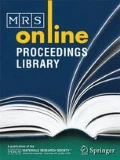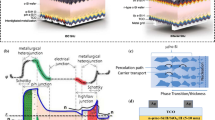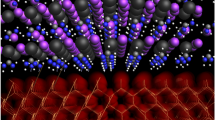Abstract
The majority of high-efficiency space solar cells being produced today are based on multi-junction devices of lattice-matched III-V materials. An alternative which has been receiving an increasing amount of attention is the lattice mis-matched or metamorphic approach to multi-junction cell development. In the metamorphic triple junction cell under development by ERI and its partners, the InGaAs junction (bottom cell) of the three-cell stack is the current limiting entity, due to the current matching which must be maintained through the device. This limitation may be addressed through the incorporation of InAs quantum dot array into the depletion region of an InGaAs cell. The InAs quantum dots in the InGaAs cell will provide subgap absorption and thus improve its short circuit current. This cell could then be integrated into the three-cell stack to achieve a space solar cell whose efficiency exceeds current state-of-the-art standards. A theoretical estimate predicts that a InGaAlP(1.95eV)/InGaAsP(1.35 eV)/InGaAs(1.2 eV) triple junction cell incorporating quantum dots to improve the bottom cell current would have an efficiency exceeding 40%. In addition, theoretical estimates have demonstrated that the use of quantum dot structures may also hold other cell benefits such as improved temperature coefficients and better radiation tolerance, which are especially important for utilization in space. As a first step towards achieving that goal, we have initiated the development of InAs quantum dots on lattice-mismatched InGaAs (1.2 eV bandgap) grown epitaxially on GaAs by metallorganic vapor phase epitaxy (MOVPE). These quantum dots have been characterized via photoluminescence (PL) and atomic force microscopy (AFM). A correlation exists between the quantum dot size and resulting optical band structure and can be controlled via the synthesis parameters. Quantum dots were incorporated into prototype InGaAs devices. A comparison of the resulting photovoltaic efficiency under simulated 1 sun intensity and air mass zero (AM0) illumination and spectral response demonstrated that an improvement in the long-wavelength photoconversion efficiency was achieved through the incorporation of the InAs quantum dots.
Similar content being viewed by others
References
S. Sinharoy, M. O. Patton, T. M. Valko, Sr., and V. G. Weizer, “Progress in the Development of Metamorphic Multi-junction III-V Space Solar Cells”, Progr. In Photovoltaics: Res. & Appl. 10, 427 (2002).
Frank Dimroth, Peter Lanyi, Mathias Meusel, Ute Schubert, and Andreas W. Bett, “New Lattice-mismatched GaInP/GaInAs Tandem Solar C ell Concepts for High Efficiency Space and Terrestrial Concentrator Solar Cells”, Proc. 16th European Photovoltaic Solar energy Conf. Glasgow, UK 1-5 May, 2000
Samar Sinharoy, Mark A. Smith, Victor G. Weizer, Anna Maria Pal, Osman Khan, David A. Scheiman, and Philip P. Jenkins, “1.62 eV/1.1 eV InGaP/InGaAs Dual-junction Solar Cell Development on Lattice-mismatched GaAs”, Proc. 28th IEEE Photovoltaic Specialists Conerence, pp1285–1288, Anchorage, AK, 15-22 Sept. 2000.
M. O. Patton, S. Sinharoy, V. G. Weizer, “Multi-junction Photovoltaic Cell”, U.S. patent #US6,660,928B1, Dec. 9 (2003).
A. Luque and A. Marti, Phys. Rev. Lett. 78, N26, 5014 (1997).
S. Kamprchum, S. Kiravittaya, R. Songmuang, S. Thainoi, S. Kanjanchuchai, M. Sawadsaringkam, and S. Panyakeow, 2002 IEEE Photovoltaics Specialists Conference, New Orleans, LA, May 20-24 (2002).
P.M. Petroff and S.P. DenBaars, Superlattice Microstructures, 15, 15 (1994).
S. Kiravittaya, R. Songmuang, S. Thainoi, S. Soppitpan, S. Kanjanchuchai, S. Ratanathammapan, M. Sawadsaringkam, and S. Panyakeow, 28th IEEE Photovoltaics Specialists Conference, Anchorage, AK (2000).
S. Kiravittaya, U. Manmontri, S. Soppitpan, S. Ratanathammapan, C. Antarasena, M. Sawadsaringkam, and S. Panyakeow, Sol. Energ. Mat. Sol. Cells 68, 89–95 (2001).
Acknowledgments
This work was supported by NASA Glenn Research Center SBIR grant #NNC04CA61C and the RIT First-In-Class program.
Author information
Authors and Affiliations
Rights and permissions
About this article
Cite this article
Raffaelle, R., Sinharoy, S., King, C.W. et al. InAs Quantum Dot Development for Enhanced InGaAs Space Solar Cells. MRS Online Proceedings Library 851, 352–360 (2004). https://doi.org/10.1557/PROC-851-NN5.7
Published:
Issue Date:
DOI: https://doi.org/10.1557/PROC-851-NN5.7




